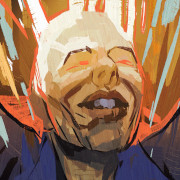|
I'm familiar with the "Mirror for Princes" genre, of which Machiavelli's "The Prince" is the most famous and probably least representative example. These were books written for rulers, and more, children of rulers to teach them how to rule and rule well. Most of them would include exemplars...stories from history and mythology that supported the moral lessons. So, for instance, a book might talk about how it's important for a ruler to keep their word, and then include an anecdote about how some historical figure or ruler kept their word when they were tempted to break it or how a ruler broke his word and the bad consequences that followed.
|
|
|
|

|
| # ? Jun 1, 2024 03:34 |
|
fantastic in plastic posted:I'm not sure I understand the science fiction part of your post. The element of Star Wars that seems more directly comparable to me than the story structure is that the aliens wear clothes and those clothes map onto audience expectations. What does the plot structure have to do with it? Sorry - this is what I deserve for posting while drinking my first coffee of the day. My point is a bit confused but I'll try to sort out what I meant. Re: Star Wars - it's genre markers. The Chivalric-Classical romances layer the recognizable and attractive genre markers of Chivalric romance on top of the Classical content in creating a product which appeals to readers. A similar thing happens in Star Wars in which SF genre markers get layered on top of a fantasy story. Roman D'Aeneas ends up a hodgepodge mix of The Aeneid and medieval Romance. A reader picks up something titled "The Romance of Aeneas" because of the classical attractions of "Aeneas" but that person still finds "Romance" more satisfying and familiar than proper classics; a viewer tunes into Star Wars because of the ostensible SF content offered by the title, but the blockbuster audience is more satisfied by the content of a Space Opera than A Space Odyssey, so to speak. In either case, more more familiar, popular content gets treated or packaged as something else. It's a strained analogy, admittedly. Re: Don Quixote - chicken and egg. It's both. He decides to become a knight errant because of his aspirations for greatness and heroism, which he models on the stories he reads, which lead him to aspire to greatness and heroism. His aspiration isn't just to be a knight, he decides to be a knight to embody the traditions and values which knights symbolize. If you're still skeptical, if you like I can try to remember to seek textual evidence when I get home - there's a passage near the beginning and one near the end which lead me to read his madness in this way. (I don't want to seem combative in this, though)
|
|
|
|
Grand Fromage posted:Things that were repurposed survive in the best condition. The Pantheon in Rome is a good example, it's almost perfectly preserved because it was converted into a church and has therefore been in continuous use. Other structures survive well because the area was abandoned, or it was just left alone for whatever reason. Something like the Colosseum was stripped of its marble and statues to build the Vatican, but the concrete structure itself was just this huge thing that you couldn't get rid of without an enormous amount of effort, and why bother. Some ancient structures were protected for religious reasons, especially in the pre-Christian era. There are some temples and such that were so old the Romans forgot what they were even there for, but weren't going to risk the wrath of the gods by loving with them. Really interesting, thanks
|
|
|
|
Epicurius posted:I'm familiar with the "Mirror for Princes" genre, of which Machiavelli's "The Prince" is the most famous and probably least representative example. These were books written for rulers, and more, children of rulers to teach them how to rule and rule well. Most of them would include exemplars...stories from history and mythology that supported the moral lessons. So, for instance, a book might talk about how it's important for a ruler to keep their word, and then include an anecdote about how some historical figure or ruler kept their word when they were tempted to break it or how a ruler broke his word and the bad consequences that followed. Ada Palmer has a really great series of essays on this and ethics, I will link it when I get home if I remember.
|
|
|
|
Herodotus is in Assassin's Creed Odyssey and there are constant references to all the bullshit he made up.
|
|
|
|
The key to cracking long-dead languages?quote:Broken and scorched black by fire, the dense, wedge-shaped marks etched into the ancient clay tablets are only just visible under the soft light at the British Museum. These tiny signs are the remains of the world’s oldest writing system: cuneiform. Dalael fucked around with this message at 19:20 on Dec 10, 2018 |
|
|
|
Well that's easily the coolest thing I read about lately. Did not realize that we had so many texts to work with.
|
|
|
|
Yeah my big hope is that someday Big Computer will be able to crack Linear A.
|
|
|
|
|
Sidenote but I forget who it was and when it was (Maybe the hobby lobby poo poo) but they mentioned several crates of shattered tablets all mixed together and I know there is some intern somewhere they tasked to put it all back together. Or they got a ceramicist I guess.
|
|
|
|
Wanna hear what crazy sex laws predated hammurabis
underage at the vape shop fucked around with this message at 06:39 on Dec 11, 2018 |
|
|
|
that is cool as hell
|
|
|
|
I found this very interesting, finds of plague in Swedish neolithic farmers may provide an explanation for the spread of the Indo-European languages. According to these finds plague may have wiped out a large part of the old Neolithic population in Europe at a time when steppe peoples were moving in in large numbers. I find it very interesting how similar this is to what I've heard about Anatolia in the Middle Ages, plague running rampant in the Greek-speaking population centers while the Turkic-speaking nomads who were moving into the area were less affected. Maybe this could provide some sort of explanation for the spread of Indo-European languages into Europe? Maybe similar things might have happened in other places where Indo-European languages came to replace the older ones, in places like Iran and northern India? https://videnskab.dk/naturvidenskab/pest-fundet-i-stenalderkvinde-forklarer-maaske-mystisk-mangel-paa-mennesker google translate from Danish with some corrections by me posted:Plague found in stone age women: May explain mysterious lack of people Judging from this site (in English) it seems that researchers have thought for a while that plague had a large part in the spread of Indo-European languages into Europe, but what the new findings indicate is that the plague wasn't spread by the steppe peoples. https://indo-european.eu/2018/12/spread-of-y-pestis-earlier-than-previously-thought-may-have-caused-neolithic-decline/ Grevling fucked around with this message at 08:25 on Dec 11, 2018 |
|
|
|
Would it be so strange if the plague first developed in steppe people and they built up some defenses against it? The traders then accidentally introduce it into a agrarian community and it then wipes them out due to the concentrated population. Then the steppes people just kind of occupy the empty space and civilization hits a soft reset of sorts.
|
|
|
|
LingcodKilla posted:Would it be so strange if the plague first developed in steppe people and they built up some defenses against it? Apparently that's what many people have been thinking, but the new findings show something else. They're a little hard to parse, but the guy who wrote the piece in the second link says that's what it means and he appears to be a geneticist (among other things) so I assume he knows his stuff.
|
|
|
|
underage at the vape shop posted:Wanna hear what crazy sex laws predated hammurabis Apparently Urukagina banned polyandry, so that must have been a thing at some point.
|
|
|
|

|
|
|
|
So I decided to pick up the "Fate of Rome" by Kyle Harper and its been interesting, I think I am about halfway through and looking at climate change as a factor of what is usually portrayed as an ultimately human narrative fascinating.
|
|
|
|
Why 536 was ‘the worst year to be alive’quote:Historians have long known that the middle of the sixth century was a dark hour in what used to be called the Dark Ages, but the source of the mysterious clouds has long been a puzzle. Now, an ultraprecise analysis of ice from a Swiss glacier by a team led by McCormick and glaciologist Paul Mayewski at the Climate Change Institute of The University of Maine (UM) in Orono has fingered a culprit. At a workshop at Harvard this week, the team reported that a cataclysmic volcanic eruption in Iceland spewed ash across the Northern Hemisphere early in 536. Two other massive eruptions followed, in 540 and 547. The repeated blows, followed by plague, plunged Europe into economic stagnation that lasted until 640, when another signal in the ice—a spike in airborne lead—marks a resurgence of silver mining, as the team reports in Antiquity this week.
|
|
|
|
The History of Byzantium podcast reached the end of Basil II's reign and he put out hist list of 5 best and worst Byzantine emperors so far. worst 5 (1 is the worst): 5. Irene 4. Justinian II 3. Phokas 2. Basiliscus 1. Justin II best 5 (1 is the best) 5. Romanus Lekapenos 4. Leo III 3. Basil II 2. Heraclius 1. Anastasius This was just a response to a listener question so he said he didn't put much thought into it but still interesting choices. I knew he thinks that Justinian was overrated but not even putting him in the top 5 was harsh.
|
|
|
|
OctaviusBeaver posted:The History of Byzantium podcast reached the end of Basil II's reign and he put out hist list of 5 best and worst Byzantine emperors so far.
|
|
|
|
HEY GUNS posted:i'd put irene among the best five Stupid Iconodules.
|
|
|
|
The dudes been on the year 1025 for like 6 months.
|
|
|
|
Shimrra Jamaane posted:The dudes been on the year 1025 for like 6 months. I think a lot of it has to do with him setting up some tours in Istanbul, and then his end of century* (well sort of because Basil's reign spans them) means there was a lot of miscellania stuff top write before picking back up.
|
|
|
|
He's making some sort of documentary of Byzantine stuff you can still see in Istanbul. He still puts out episodes every week they just haven't moved the narrative forward in a while.
|
|
|
|
I think the next episode is back to the narrative, if not it's the one after. I don't mind at all, this is the period of Roman history I know the least about so the more detail the better.
|
|
|
|
Plus this is a major turning point for the empire. Best to wrap up everything happening in Roman society now because its going to be downhill and poo poo on for the next several hundred years.
|
|
|
|
Right, early 900s through mid 1000s is the peak of power for the medieval empire so there's a lot to talk about. Their brief moment of being a truly fearsome power again, all their enemies lying defeated.
|
|
|
|
So what happened between 1025 and everything going to absolute poo poo in 1077? I know that Basil II painted the map by reconquering Bulgaria and Eastern Anatolia but did that really translate to the Empire being as strong as it looks on a map in 1025? Or were the seeds of the disasters later in the century already planted?
Shimrra Jamaane fucked around with this message at 18:05 on Dec 19, 2018 |
|
|
|
Shimrra Jamaane posted:So what happened between 1025 and everything going to absolute poo poo in 1077? I know that Basil II painted the map by reconquering Bulgaria and Eastern Anatolia but did that really translate to the Empire being as strong as it looks on a map in 1025? Or were the seeds of the disasters later in the century already planted? Fuckin' nobles, man. Give them an inch and they'll hollow the empire out from within.
|
|
|
|
Shimrra Jamaane posted:The dudes been on the year 1025 for like 6 months. 
|
|
|
|
It's mainly the infighting that crops up because Basil couldn't be bothered to groom a successor. How many emperors left the succession either unresolved? You'd think with a fair number in your history you'd be mindful of succession. Another one of those "Those who do not remember the past are doomed to repeat it" situations. And then the Turks come in during a period of infighting and crush the Romans. That, and as the podcast helpfully pointed out in a recent episode, the Roman military was built to fight a foe with fixed locations and a standing army. Not so great against a steppe people on horseback. It was a one-two punch the empire would struggle (and ultimately fail) to recover from.
|
|
|
|
Thwomp posted:It's mainly the infighting that crops up because Basil couldn't be bothered to groom a successor. How many emperors left the succession either unresolved? You'd think with a fair number in your history you'd be mindful of succession. Another one of those "Those who do not remember the past are doomed to repeat it" situations. At least we got to see such luminaries as "Michael the Forger" and "Michael the Caulker" ascend to the Imperial throne.
|
|
|
|
The attitudes involved in seeking, taking, and maintaining ultimate power for a long time are a little opposed to things like sharing power, building up strong, stable institutions, and trying to do the best for your nation rather than yourself. Just look at all the ones who just had to step up and take down big popular powerful people for fear that they would take power. It's rational for them, but if competence or popularity carries a death sentence, of course it's going to end up with a strongman at the center of everything so that it all collapses to poo poo when he kicks the bucket.
|
|
|
|
Thwomp posted:It's mainly the infighting that crops up because Basil couldn't be bothered to groom a successor. How many emperors left the succession either unresolved? You'd think with a fair number in your history you'd be mindful of succession. Another one of those "Those who do not remember the past are doomed to repeat it" situations. Yeah seriously. Set up a loving succession when you're a powerful emperor who can make it stick. Basil II just shrugging it off was idiotic. Anyway this century of kicking rear end was also partly a confluence of lucky events. The empire had a string of pretty good rulers, the civil strife wasn't that bad, and all of their enemies were settled states with standing armies, aka the type of enemy the Roman military was designed to defeat. The army was taken care of decently, led well, and none of their enemies were coordinated. The days of Islamic unity were long gone and the Romans were able to trounce all their assorted Islamic neighbors and reduce them to tributaries. The Bulgarians had settled down into a state that Basil II could defeat and place under some measure of imperial control. The Turks were a really tough enemy to deal with at the best of times, they were badass. Also my understanding is Manzikert wasn't actually that bad of a defeat, but the empire was too busy up its own rear end and infighting to deal with it. If there had been better leadership they could've dealt with it. It's not like the Turks immediately took over Anatolia after Manzikert, that's just where historians have placed the beginning of the end with hindsight since it was the first major Turkish victory. It was by no means guaranteed that battle was going to lead to anything. It's not as if the empire hasn't recovered after losing battles plenty of times before. Also the Normans show up right about the same time as the Turks and start conquering the western reaches of the empire, making even more of a distraction.
|
|
|
|
You guys are thinking about what's best for the country. An autocrat thinks about what's best for themselves. What you see as a successor an autocrat sees a rival. Once you make it clear that Johnny boy here gets the job once you die, it's now in Johnny boy's interests to help you get there. Designating someone your successor is, in a significant way, giving them some of your power and authority.
|
|
|
|
It’s funny how the very first loving Emperor ran into succession problems and yet the Empire continued to deal with them for another 1400 years.
|
|
|
|
Because the only people you can really trust with that, if anyone, is your own children, and infant mortality and the length of the average reign being what they were, even if you had a son at hand he was usually too young to hold onto power.
|
|
|
|
Augustus had an unusually clean succession tbh. His favored and backup successors died before him but he was prepared with a backup backup. I can't imagine most other emperors going to those lengths
|
|
|
|
What I was saying earlier is also why so many left it to their deathbed before they designated a successor. It was too dangerous to do so even a day beforehand.
|
|
|
|

|
| # ? Jun 1, 2024 03:34 |
|
Augustus‘ succession was clean because his power was so long-lasting and unquestionable that his chosen successor could neither reasonably rebel against him before death, nor reasonably be set aside by anyone else after his death. Most other emperors had nowhere near that level of security.
|
|
|




































